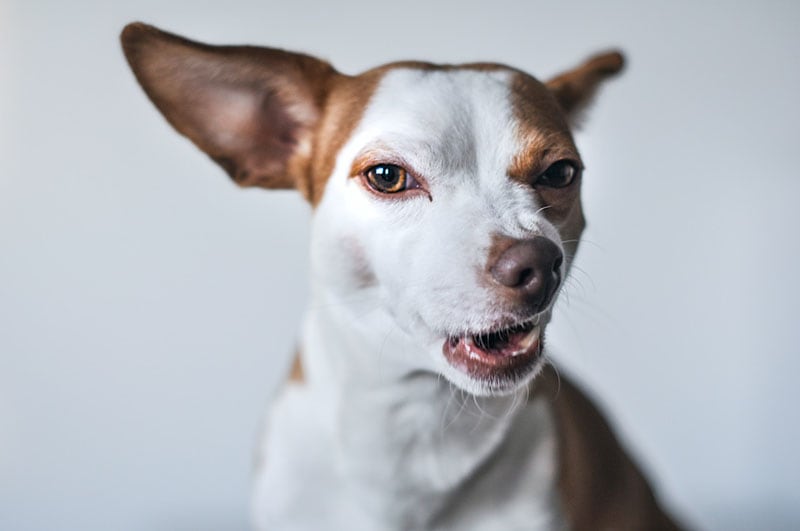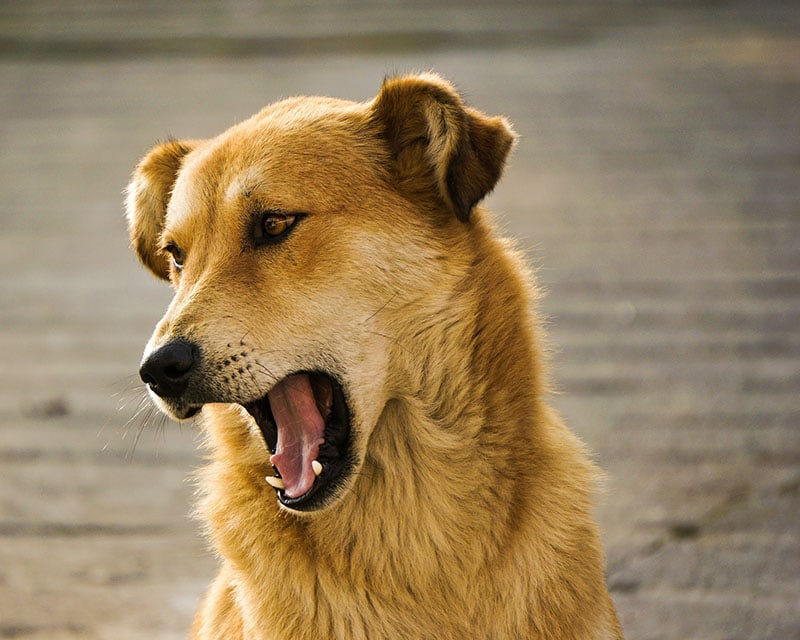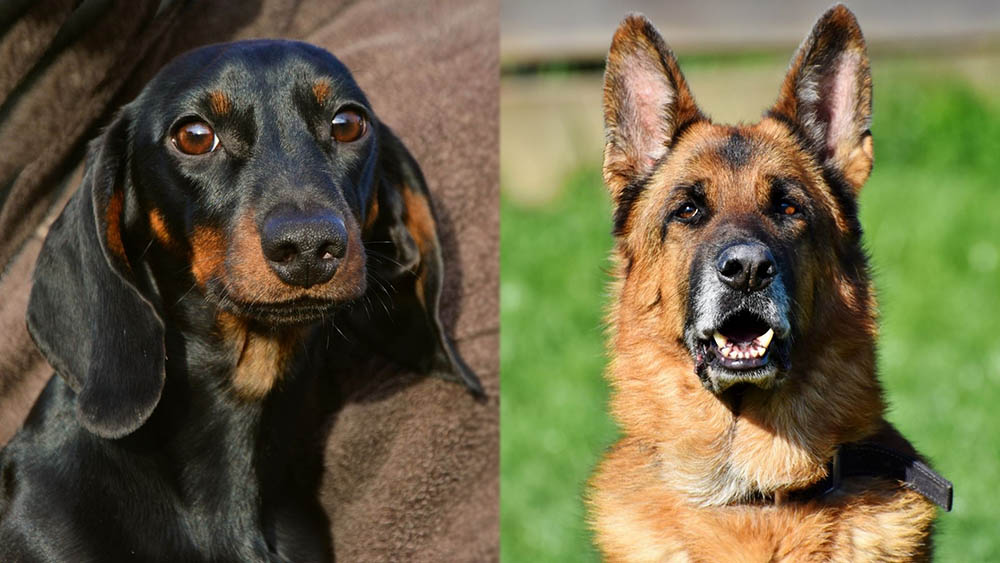What Is Flehmen Response in Dogs: What Is It & Why They Do It?

Updated on

Our dogs often have us in stitches with laughter with their weird and wonderful behavior. They chase their tails, sniff butts, walk in circles, and sometimes appear to be smiling when they do that strange thing that exposes their teeth. That is called the flehmen response, and it actually serves a purpose.
It is also known as the flehmen reaction, flehmening, or the flehmen position and is a behavior that involves your dog curling back its upper lip, showing its teeth, and inhaling. When dogs do this, their teeth can sometimes chatter, making it more amusing and somewhat puzzling to witness. In this article, we’ll talk more about the flehmen response, what it is, and why they do it. Let’s have a look!
What is the Flehmen Response?
The flehmen response can be seen in several mammals, including our dogs, and is recognized by a dog exposing its teeth by curling back its upper lip. The name comes from the German word flemmen, which translates to “to look spiteful’ which may explain why it may look like your dog is smiling smugly at you.
You will notice your dog sporting the flehmen response when they detect an interesting sight or smell. The purpose of the flehmen response is to transfer pheromones and other scents into the vomeronasal organ (VNO) above the roof of the mouth. When a dog curls its lips, it exposes the VNO to make it easier to pick up a scent.
Because of a dog’s extraordinary sense of smell, they don’t usually display the flehmen response as often as cats and other mammals, so it can be a rare occurrence in dogs, and it can often be mistaken for aggression as their teeth are exposed. Many dogs display a response called tonguing, which is similar to the “lip curl” flehmen response seen in other mammals.
Tonguing is when a dog quickly pushes its tongue against the roof of its mouth, and the teeth occasionally rattle. Tonguing is commonly seen after a dog “tastes the air” or licks a urine stain, which occurs after two rival males have exchanged mutual threat signals, or if a male is looking for a mate.

How Does It Work?
The flehmen response works by exposing the vomeronasal organ (VNO), also known as the Jacobson organ, by curling back the upper lip. When a dog or mammal curls back its lip, it draws in air to the VNO. This organ is a long, pouch-like structure lined with olfactory receptor cells. The auxiliary olfactory bulb (AOB), which receives scent information from these receptor cells, transmits it straight to the limbic system.
The VNO is distinct from other smell channels in that it has a direct connection to the brain. You might even refer to it as a sixth sense.
Why Do They Do It?
Animals will deliberately leave their scent for others by urinating on many objects they encounter. Females will release pheromones to indicate they are ready to conceive, and males will pick up the scent through the female’s urine.
The VNO is a functional organ that is important to dogs, even though it may be less well developed in them than in some other animals. There is little known about the importance of VNO information in dogs. However, it certainly plays a functional role in the interchange of pheromone communication related to social status and the animal’s reproductive status.
What Can They Pick Up from a Scent?
A dog’s sense of smell is extraordinary, and they utilize it to assess their surroundings and obtain information about their environment. It helps them learn, make decisions and identify people and communicate. In one single sniff, dogs use the amines and acids emitted by other dogs as a base for communication.
The chemical aromas reveal a dog’s preferred foods, as well as its sex and temperament. It can tell whether a strange dog is male or female, happy or hostile, or healthy or unwell just by smelling them. A brief sniff gives dogs a rough sense of each other, but getting close gives them more specific information. Dogs also have incredible scent memory, which can help them recognize a dog they met years prior and even remember if it was the dominant member of the pack.

A dog can sniff a tree in an unfamiliar environment to find out which dogs live nearby. Dogs also have an excellent homing instinct based on their sense of smell. They may use their sense of smell as a compass to determine the direction of a scent because they can move their nostrils independently.
The VNO interacts with the brain region responsible for mating, so it can tell the dog if there is a member of the opposite sex available for mating by identifying the pheromones. Furthermore, it improves a pup’s sense of smell so that it can locate its mother’s milk supply and tell her apart from other nursing dogs. This enhanced sense of smell also helps the pup find its mother if it becomes lost.
Frequently Asked Questions (FAQs)
Can Humans Use the Flehmen Response?
There is no flehmen response in humans, but there has been some controversy regarding the presence of a VNO in humans. A Danish surgeon insisted it does not exist in humans, but more recent research raises the possibility that humans may still contain a vestigial version of the VNO. However, more investigation is required to determine whether humans use the vomeronasal organ similarly to other mammals.
Is the Flehmen Response in Dogs a Sign of Aggression?
The flehmen response is not associated with aggression but may be confused with aggressive behavior. A dog may sometimes retract its lips vertically, often referred to as a “submissive grin,” and it can be an indication of social uneasiness rather than an aggressive threat.

What Are the Signs of the Flehmen Response in Dogs?
The top lip of animals that display the flehmen response will curl back, revealing the front teeth and gums. Dogs will occasionally chatter their teeth and appear like they have a snarky grin.
Conclusion
The flehmen response is a behavior displayed in many animals, including dogs, to detect interesting smells. In dogs, it is typically used to detect pheromones in a female dog’s urine. When a dog displays the flehmen response, their upper lip will curl back, exposing its teeth, which often looks like a smug grin.
While dogs occasionally display the flehmen response, they don’t do it as often as cats and other animals, as their primary sense of smell is so powerful.
See Also:
Featured Image Credit: Isabel Vittrup-Pallier, Unsplash












